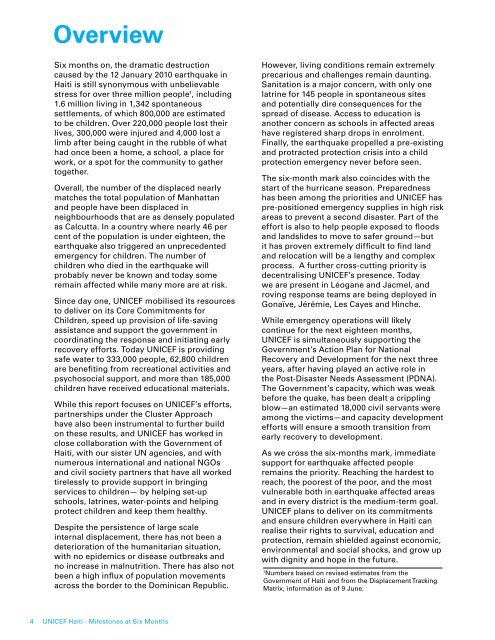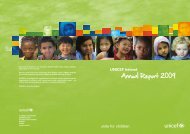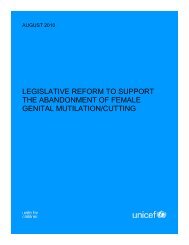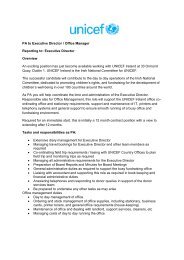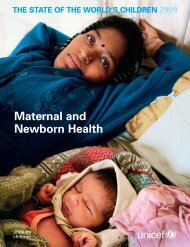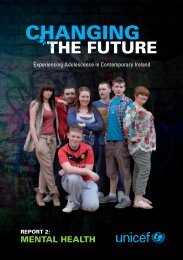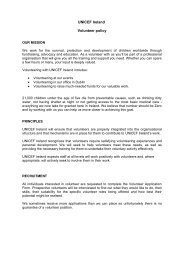CHILDREN OF HAITI - Unicef
CHILDREN OF HAITI - Unicef
CHILDREN OF HAITI - Unicef
You also want an ePaper? Increase the reach of your titles
YUMPU automatically turns print PDFs into web optimized ePapers that Google loves.
Overview<br />
Six months on, the dramatic destruction<br />
caused by the 12 January 2010 earthquake in<br />
Haiti is still synonymous with unbelievable<br />
stress for over three million people 1 , including<br />
1.6 million living in 1,342 spontaneous<br />
settlements, of which 800,000 are estimated<br />
to be children. Over 220,000 people lost their<br />
lives, 300,000 were injured and 4,000 lost a<br />
limb after being caught in the rubble of what<br />
had once been a home, a school, a place for<br />
work, or a spot for the community to gather<br />
together.<br />
Overall, the number of the displaced nearly<br />
matches the total population of Manhattan<br />
and people have been displaced in<br />
neighbourhoods that are as densely populated<br />
as Calcutta. In a country where nearly 46 per<br />
cent of the population is under eighteen, the<br />
earthquake also triggered an unprecedented<br />
emergency for children. The number of<br />
children who died in the earthquake will<br />
probably never be known and today some<br />
remain affected while many more are at risk.<br />
Since day one, UNICEF mobilised its resources<br />
to deliver on its Core Commitments for<br />
Children, speed up provision of life-saving<br />
assistance and support the government in<br />
coordinating the response and initiating early<br />
recovery efforts. Today UNICEF is providing<br />
safe water to 333,000 people, 62,800 children<br />
are benefiting from recreational activities and<br />
psychosocial support, and more than 185,000<br />
children have received educational materials.<br />
While this report focuses on UNICEF’s efforts,<br />
partnerships under the Cluster Approach<br />
have also been instrumental to further build<br />
on these results, and UNICEF has worked in<br />
close collaboration with the Government of<br />
Haiti, with our sister UN agencies, and with<br />
numerous international and national NGOs<br />
and civil society partners that have all worked<br />
tirelessly to provide support in bringing<br />
services to children— by helping set-up<br />
schools, latrines, water-points and helping<br />
protect children and keep them healthy.<br />
Despite the persistence of large scale<br />
internal displacement, there has not been a<br />
deterioration of the humanitarian situation,<br />
with no epidemics or disease outbreaks and<br />
no increase in malnutrition. There has also not<br />
been a high influx of population movements<br />
across the border to the Dominican Republic.<br />
However, living conditions remain extremely<br />
precarious and challenges remain daunting.<br />
Sanitation is a major concern, with only one<br />
latrine for 145 people in spontaneous sites<br />
and potentially dire consequences for the<br />
spread of disease. Access to education is<br />
another concern as schools in affected areas<br />
have registered sharp drops in enrolment.<br />
Finally, the earthquake propelled a pre-existing<br />
and protracted protection crisis into a child<br />
protection emergency never before seen.<br />
The six-month mark also coincides with the<br />
start of the hurricane season. Preparedness<br />
has been among the priorities and UNICEF has<br />
pre-positioned emergency supplies in high risk<br />
areas to prevent a second disaster. Part of the<br />
effort is also to help people exposed to floods<br />
and landslides to move to safer ground—but<br />
it has proven extremely difficult to find land<br />
and relocation will be a lengthy and complex<br />
process. A further cross-cutting priority is<br />
decentralising UNICEF’s presence. Today<br />
we are present in Léogane and Jacmel, and<br />
roving response teams are being deployed in<br />
Gonaïve, Jérémie, Les Cayes and Hinche.<br />
While emergency operations will likely<br />
continue for the next eighteen months,<br />
UNICEF is simultaneously supporting the<br />
Government’s Action Plan for National<br />
Recovery and Development for the next three<br />
years, after having played an active role in<br />
the Post-Disaster Needs Assessment (PDNA).<br />
The Government’s capacity, which was weak<br />
before the quake, has been dealt a crippling<br />
blow—an estimated 18,000 civil servants were<br />
among the victims—and capacity development<br />
efforts will ensure a smooth transition from<br />
early recovery to development.<br />
As we cross the six-months mark, immediate<br />
support for earthquake affected people<br />
remains the priority. Reaching the hardest to<br />
reach, the poorest of the poor, and the most<br />
vulnerable both in earthquake affected areas<br />
and in every district is the medium-term goal.<br />
UNICEF plans to deliver on its commitments<br />
and ensure children everywhere in Haiti can<br />
realise their rights to survival, education and<br />
protection, remain shielded against economic,<br />
environmental and social shocks, and grow up<br />
with dignity and hope in the future.<br />
1<br />
Numbers based on revised estimates from the<br />
Government of Haiti and from the Displacement Tracking<br />
Matrix, information as of 9 June.<br />
4 UNICEF Haiti - Milestones at Six Months


